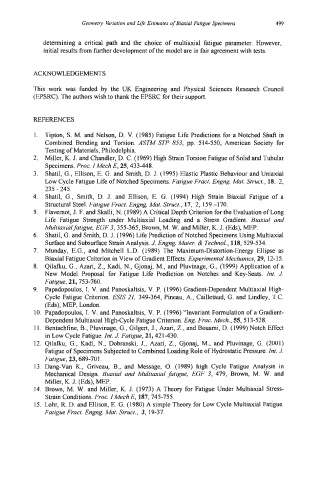Page 515 - Biaxial Multiaxial Fatigue and Fracture
P. 515
Geomehy Variation and Life Estimates of Biaxial Fatigue Specimens 499
determining a critical path and the choice of multiaxial fatigue parameter. However,
initial results from further development of the model are in fair agreement with tests.
ACKNOWLEDGEMENTS
This work was funded by the UK Engineering and Physical Sciences Research Council
(EPSRC). The authors wish to thank the EPSRC for their support.
REFERENCES
1. Tipton, S. M. and Nelson, D. V. (1985) Fatigue Life Predictions for a Notched Shaft in
Combined Bending and Torsion. ASTM STP 853, pp. 514-550, American Society for
Testing of Materials, Philedelphia.
2. Miller, K. J. and Chandler, D. C. (1969) High Strain Torsion Fatigue of Solid and Tubular
Specimens. Proc. I Mech E, 25,433-448.
3. Shatil, G., Ellison, E. G. and Smith, D. J. (1995) Elastic Plastic Behaviour and Uniaxial
Low Cycle Fatigue Life of Notched Specimens. Fatigue Fract. Engng Mat. Struct., 18, 2,
235 - 245.
4. Shatil, G., Smith, D. J. and Ellison, E. G. (1994) High Strain Biaxial Fatigue of a
Structural Steel. Fatigue Fract. Engng. Mat. Struct., 17, 2, 159 -170.
5. Flavernot, J. F. and Skalli, N. (1989) A Critical Depth Criterion for the Evaluation of Long
Life Fatigue Strength under Multiaxial Loading and a Stress Gradient. Biaxial and
Multiaxial fatigue, EGF 3,355-365, Brown, M. W. and Miller, K. J. (Eds), MEP.
6. Shatil, G. and Smith, D. J. (1996) Life Prediction of Notched Specimens Using Multiaxial
Surface and Subsurface Strain Analysis. J. Engng. Mater. & Technol., 118,529-534.
7. Munday, E.G., and Mitchell L.D. (1989) The Maximum-Distortion-Energy Ellipse as
Biaxial Fatigue Criterion in View of Gradient Effects. Experimental Mechanics, 29, 12-15.
8. Qilafku, G., hri, Z., Kadi, N., Gjonaj, M., and Pluvinage, G., 0999) Application of a
New Model Proposal for Fatigue Life Prediction on Notches and Key-Seats. Int. J.
Fatigue, 21,753-760.
9. Papadopoulos, I. V. and Panoskaltsis, V. P. (1996) Gradient-Dependent Multiaxial High-
Cycle Fatigue Criterion. ESIS 21, 349-364, Pineau, A., Cailletaud, G. and Lindley, T.C.
(Eds), MEP, London.
10. Papadopoulos, I. V. and Panoskaltsis, V. P. (1996) “Invariant Formulation of a Gradient-
Dependent Multiaxial High-Cycle Fatigue Criterion. Eng. Frac. Mech., 55, 5 13-528.
11. Bentachfine, B., Pluvinage, G., Gilgert, J., Azari, Z., and Bouami, D. (1999) Notch Effect
in Low Cycle Fatigue. Int. J. Fatigue, 21,42 1-430.
12. Qdafku, G., Kadi, N., Dobranski, J., Azari, Z., Gjonaj, M., and Pluvinage, G. (2001)
Fatigue of Specimens Subjected to Combined Loading Role of Hydrostatic Pressure. Int. .I.
Fatigue, 23,689-701.
13. Dang-Van K., Griveau, B., and Message, 0. (1989) high Cycle Fatigue Analysis in
Mechanical Design. Biaxial and Multiaxial fatigue, EGF 3, 479, Brown, M. W. and
Miller, K. J. (Eds), MEP.
14. Brown, M. W. and Miller, K. J. (1973) A Theory for Fatigue Under Multiaxial Stress-
Strain Conditions. Proc. I Mech E, 187,745-755.
15. Lohr, R. D. and Ellison, E. G. (1980) A simple Theory for Low Cycle Multiaxial Fatigue.
Fatigue Fract. Engng. Mat. Struct., 3, 19-37.

